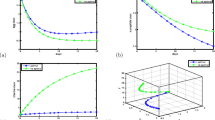Abstract
Plant protection problems are simulated by a system of ordinary differential equations with given initial conditions. The sensitivity and resistance of pathogen subpopulations to fungicide mixtures, fungicide weathering, plant growth, etc. are taken into consideration. The system of equations is solved numerically for each set of initial conditions and parameters of the disease and fungicide applications. Optimization algorithms were investigated and a computer program was developed for optimization of these solutions. 14 typical cases of the disease were simulated and optimized in order to determine optimal fungicide treatments. The optimized strategy for fungicide application differs considerably from the commonly used method and seems to be an important new principle in plant protection. The approach developed in this study may be useful for a wide spectrum of purposes in the simulation of leaf diseases. It may also help the biologist to decrease or pinpoint experimental work and analyze its results and is perspective for plant disease control.
Similar content being viewed by others
REFERENCES
Doster, M.A., M.G. Milgroom and W.E. Fry (1990). Quantification of factors influencing potato late blight suppression and selection for metalaxyl resistance in Phytophthora infestans: A simulation approach. Phytopathology 80: 1190-1198.
Doster M.A. and W.E. Fry (1991). Evaluation by computer simulation of strategies to time metalaxyl applications for improved control of potato late blight. Crop protection 10: 203-214.
Gelfand I.M., E.B. Vool, S.A. Ginzburg and Yu.G. Fedorov (1966). Ravine method for X-ray analysis of structures. Nauka, Moscow.
Hooke R. and T.A. Jevees (1961). “Direct search” solution of numerical and statistical problems. Journal of the Association for Computing Machinery 8: 212-219.
Kable P.F. and H. Jeffery (1980). Selection for tolerance in organisms exposed to sprays of biocide mixtures: A theoretical model. Phytopathology 70: 8-12.
King R. (1997). A structured mathematical model for a class of organisms: I. Development of a model for Streptomyces tendae and application of model-based control. Journal of Biotechnology 52: 219-234.
Levy Y. and R.S. Levy (1986). Control strategies using systemic fungicides for limiting disease development or resistance buildup: Practical applications of a simulation model. Phytoparasitica 14: 303-312.
Levy Y., R.S. Levi and Y. Cohen (1983). Buildup of a pathogen subpopulation resistant to a systemic fungicide under various control strategies: A flexible simulation model. Phytopathology 73: 1475-1480.
Levy Y., Y. Cohen and M. Benderly (1991). Disease development and buildup of resistance to oxadixyl in potato crops inoculated with Phytophthora infestans as affected by oxadixyl and oxadixyl mixtures: Experimental and simulation studies. Journal of Phytopathology 132: 219-229.
Milgroom M.G. and W.E. Fry (1988). A simulation analysis of the epidemiological principles for fungicide resistance management in pathogen populations. Phytopathology 78: 565-570.
Powell M.J.D. (1964). An efficient method for finding the minimum of a function of several variables without calculating derivatives. Computer Journal 7: 155-162.
Rosenbrock H.H. (1960/61). An automatic method for finding the greatest or least value of a function. Computer Journal 3: 175-184.
Salt D.W. and M.G. Ford (1996). The kinetics of insecticide action. Part V: Deterministic models to simulate the movement of pesticide from discrete deposits and to predict optimum deposit characteristics on leaf surfaces for control of sedentary crop pests. Pesticide Science 48: 77-87.
Samoucha Y., A. Baider, Y. Cohen and U. Gisi (1992). Control of late blight in potato by oxadixyl mixtures at reduced rates. Phytoparasitica 20: 235-236.
Vasiliev O.V. (1996). Optimization methods. World Federation Publishers Company, Atlanta, GA.
Author information
Authors and Affiliations
Rights and permissions
About this article
Cite this article
Kelman, E., Levy, R. & Levy, Y. Optimization of Solutions for the One Plant Protection Problem. Acta Biotheor 49, 61–71 (2001). https://doi.org/10.1023/A:1010293826427
Issue Date:
DOI: https://doi.org/10.1023/A:1010293826427




